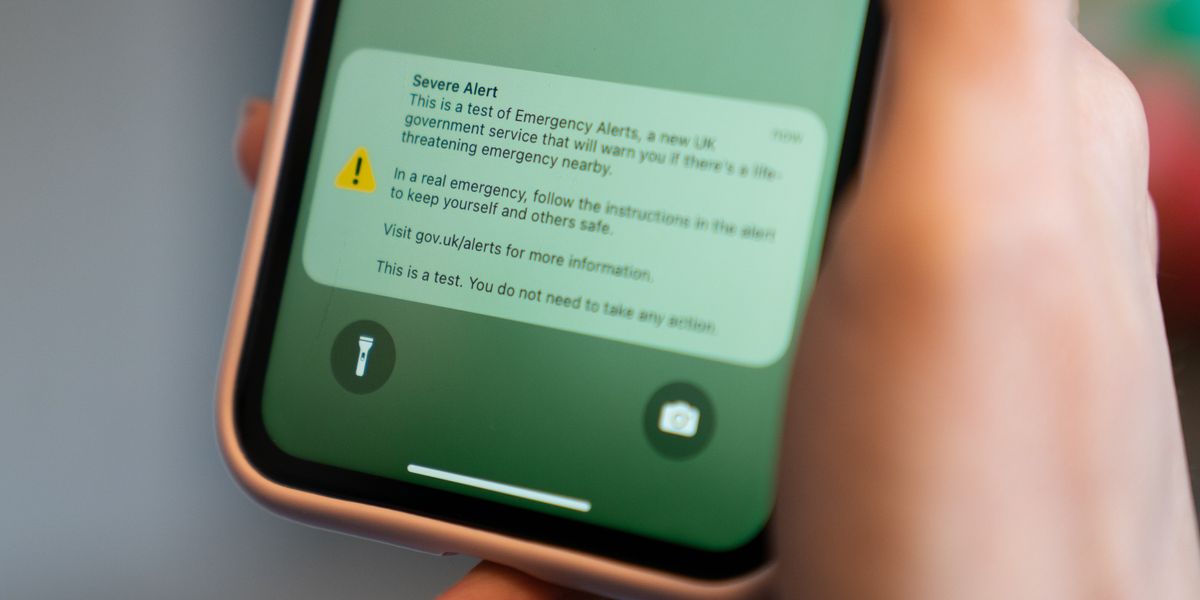Keir Starmer’s Government has confirmed plans to test the UK’s Emergency Alert System later this year as part of a major pandemic preparedness exercise. When triggered, the alert causes smartphones and tablets to emit a loud siren-like sound and vibrate — even when the device is set to silent mode.
Alongside the piercing alarm sound, the Emergency Alert System (EAS) displays a notification on-screen. EAS is designed to warn people about a “life-threatening emergency” nearby and deliver critical information.
While the next trial of the system will be nationwide, in practice, the system will be used to warn Britons about severe flooding, fires and extreme weather in their local area.
The UK Government has already tested this nationwide alarm system multiple times since it was introduced in two years ago
PRESS ASSOCIATION
Several countries outside of the UK have a similar warning system, including Australia, South Korea, United States of America, New Zealand, Japan, and Canada. EU countries must participate in the EU-wide alert system too.
The UK Government has trialled EAS four times since it was launched back in 2023. No specific date has been confirmed for the incoming test, which will align with a multi-day exercise scheduled for autumn 2025.
If you don’t want your phone or tablet to blare with a siren-like sound, there is a way to opt-out and disable the system buried within the settings of most modern devices, including iPhone and Android. Follow the step-by-step instructions below to switch-off the UK warning system.
Depending on how many apps you have installed on your iPhone or iPad, it can take a while to scroll down the Notifications menu to find the option to disable these siren-like alerts
APPLE PRESS OFFICE
How to disable UK Emergency Alerts on iPhone
- Unlock your iPhone and open Settings
- Tap on Notifications
- Scroll down toEmergency Alerts
- Switch off the options marked Extreme Alerts and Severe Alerts
Alternatively, you can tap on the option marked Emergency Alerts and uncheck Always Play Sounds. This will prevent the UK-wide alert system from emitting a sound from your iPhone when it’s on Silent mode. However, if you have notifications and sounds enabled across the operating system, the Government alerts will work.
Android lets you disable the emergency alerts within Settings, but depending on the manufacturer, the option within the Settings menu could be labelled differently
GOOGLE PRESS OFFICE
How to disable UK Emergency Alerts on Android
If you have a smartphone or tablet built by Google, Samsung, Xiaomi, OnePlus, Nokia, or any other major manufacturer that relies on the Android operating system, the following guide should help you block the siren-like alerts from the UK Government.
- Unlock your device and launch Settings
- Scroll down to Safety and Emergency
- Tap the option marked Wireless Emergency Alerts
- Switch off Allow Alerts
- You can also toggle individual options for Extreme Alerts and Severe Alerts
Some Android brands might use slightly different wording or menu layouts, but the options will be similar.
If your device doesn’t have the ability to manually disable these types of alerts, switching on Aeroplane Mode or removing the SIM card from your phone or tablet will prevent the UK EAS alert getting through. Of course, if you have an eSIM, you won’t be able to ditch this all-important card from your device.
The EAS broadcasts its warnings via mobile phone masts to compatible devices within range. It doesn’t require mobile data or Wi-Fi connection to function, so simply disabling wireless internet in the Settings is not enough to block these intrusive warnings. For complete certainty, you can switch off the devices entirely.
The UK Government recommends keeping alerts enabled for safety purposes. The system is still being tested, but should there be a national — or local — emergency that requires EAS, it’s not the kind of notification that you want to miss.
Cabinet Office minister Pat McFadden said the UK Government plans to train thousands of people to be better prepared for crises, like pandemics. The exercise will be conducted over several months in autumn, marking a significant effort to bolster the UK’s response capabilities to future health emergencies.
Special attention will be given to vulnerable groups, including elderly and disabled people, who were disproportionately affected during the COVID-19 pandemic. The comprehensive drill will test coordination between multiple agencies and authorities across the UK.
All Government departments will participate alongside local councils and emergency services. The devolved authorities will also play a key role in the exercise, ensuring nationwide preparedness.
This represents one of the largest emergency preparedness exercises in recent years, focusing specifically on pandemic scenarios.
The warning system — designed to quickly send life-saving information about severe flooding, fires and extreme weather — can swerve silent modes on your device to trigger a sound
PRESS ASSOCIATION
The Emergency Alert System works by using local mobile phone masts to broadcast warnings to all compatible devices in range. When activated, the alert causes phones to vibrate and emit a siren sound for approximately 10 seconds, while also reading the message aloud.
Since its launch in 2023, the system has been deployed four times for various emergencies.
LATEST DEVELOPMENTS
The most recent use was on 6 January 2025, warning people at caravan parks near Barrow upon Soar in Leicestershire about potential flooding from the River Soar. In December 2024, residents in Wales and southwest England received alerts about extreme winds from Storm Darragh.
The system has also been used for more unusual emergencies, including an alert from Plymouth City Council warning locals about the transportation of a World War Two bomb discovered in a garden.

